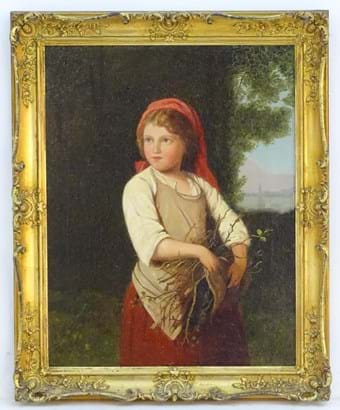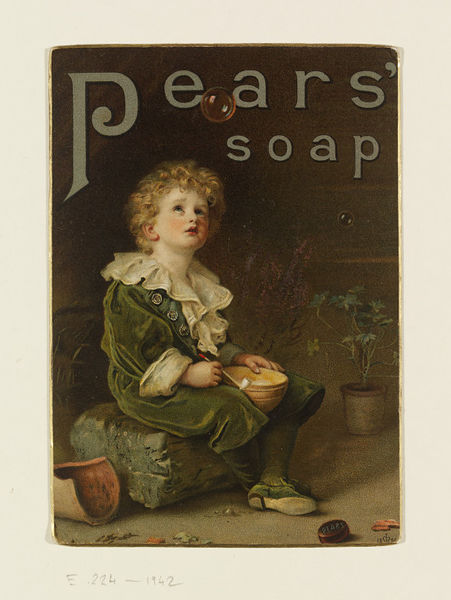The Art of Advertising

XIX-XX, Oil on canvas, Girl Gathering Sticks
The Victorian era saw the rise of consumerism, which in turn increased the attraction of collecting. This rise was perhaps fuelled by world fairs, such as the Great Exhibition of 1851, which showcased thousands of achievements and fascinating objects from all nations. These expositions were popular places for companies to distribute product cards as well as illustrate their wares. The presentation of items and artworks broadened the minds of people of all levels of society, so collecting became a pastime enjoyed by many Victorians. While the wealthier middle and upper class individuals might visit auction houses to bid vast sums of money on artefacts and curios of the world, lower classes were collectors too.
The late 19th century saw the emergence of the trade card; these were early examples of the modern business card, used by business proprietors to advertise their trade. This style of advertising was driven by the advancement of chromolithography, allowing businesses to cheaply produce colourful images to attract the attention of consumers. Trade cards were not limited to specific commodities, but were used to advertise products from various sectors, promoting products from medicine and food, to tobacco and household goods. The common format for trade cards was to have an illustration on the front of the card and the goods and services supplied detailed on the reverse. Similar to modern visual advertising, the colourful image on the cards did not necessarily have any relevance to the business it was promoting, instead appealing to the customer’s taste, often showing images of children, flowers and animals to appeal to the Victorian taste.
Art and advertising have always been inextricably entwined; some of the most famous artists in the world began their careers in advertising. Think for example of Andy Warhol, who began his career producing advertising illustrations for Glamour magazine, before going on to be one of the leading artists of the Pop Art movement. In order to make an impact on consumers, Victorian traders commissioned notable artists to design their cards.
The pioneer of the production of trade cards was the Liebig Extract of Meat Company (later OXO), their creations ahead of all other industries by at least a decade. From the 1870s, Justus von Liebig used trade cards to promote his business. From the beginning, these were of outstanding quality, exhibiting extraordinary artistry in great detail. The trade cards depicted a wide range of universal themes, varying from historical episodes, marvels of the world, exotic peoples, flowers, children and much more, with the company’s information, useful information such as the nutritional value of Liebig products and recipe suggestions, detailed on the reverse. Unusually, these trade cards were produced and distributed on an international scale. This was a cheap and effective way of reaching consumers. Additionally, each card was released as part of a series of six thematically linked lithographs, providing an incentive for customer loyalty with the excitement of completing the series. The beautiful nature of the images adorning the trade cards and the collectability of the sets captured the imagination of the Victorians, who became keen collectors of these portable adverts.
In the case of Liebig, its concentrated beef extract was a cheap and nutritious substitute for those unable to afford meat, their products were not necessarily aimed at the higher levels of society, hence why their trade cards were revered by all - you did not have to be literate to experience the beauty of the image. These graphic advertisements were not throwaway fragments of a promotional culture, but portable advertisements that acquired the status of miniature artworks, collected and traded as artistic souvenirs by all social classes.

Our Paintings & Prints auction on Wednesday 29th April, features an original oil on canvas design for one of Liebig’s chromolithographic trade cards. The card produced from the painting (Figure 1) is part of a set of six cards, each depicting an image of a child. The painting (Lot 9, Figure 2) depicts a young girl gathering sticks in a landscape with a church spire in the distance. Whilst the artist is unknown, the attractive design and excellent execution of the painting is in keeping with the level of quality of Liebig’s prints.

A decade later, Pears’ Soap began producing their renowned advertising trade cards. However, they took their advertising campaigns to the next level by coupling fine art and commercialism. This was achieved by Thomas Barratt, who purchased original paintings by famous British artists of the day and modified them to include Pears’ products. Perhaps the most famous is Sir John Everett Millais’ painting Bubbles, to which a bar of Pears’ soap was superimposed (Figure 3). Incidentally, the wonderful advertising prints produced by Pears’ Soap can be picked up at auction for a fraction of the price they would once have made!

By Jen Mason
